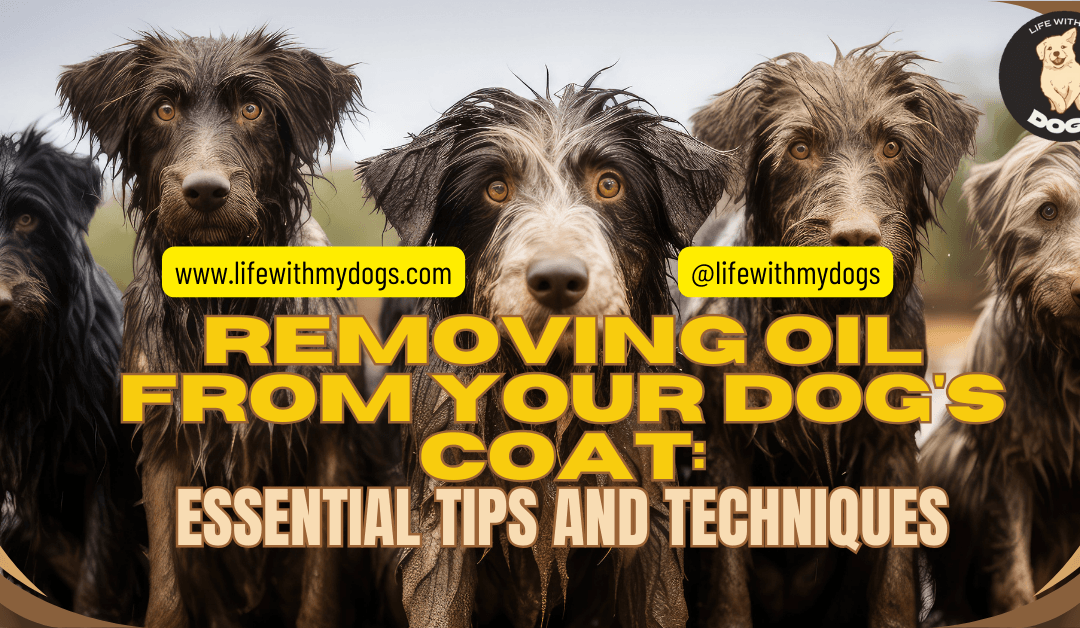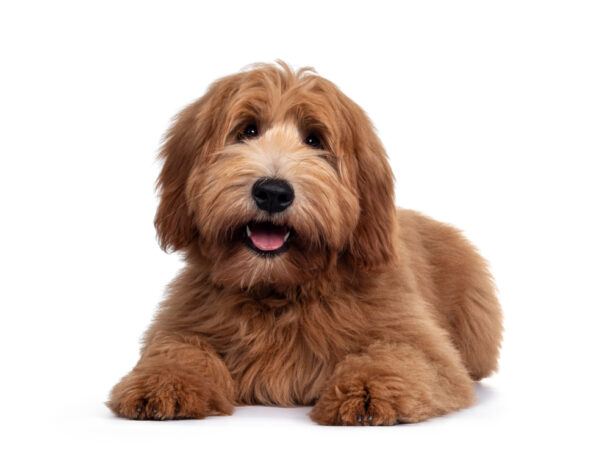LifeWithMyDogs is supported by our audience. When you purchase through one of our links, we may earn a small affiliate commission. As an Amazon Associate I earn from qualifying purchases. Your cost is not affected.
**********
Removing oil from your dog’s coat can indeed pose a real challenge. I’ve experienced the unfortunate situation of spilling oil during a DIY project, and let me tell you, it was truly messy, especially on my white dog’s fur! Dealing with oily messes can be both frustrating and concerning.
But fear not! Through my own experiences and research, I’ve gained invaluable insights and learned some effective tips and tricks for safely removing oil from our furry friends’ coats. From quick cleanup strategies to natural remedies, I’m excited to share what I’ve learned and guide you through the process.
A Comprehensive Guide to Removing Oil from Your Dog’s Coat

Accidents happen, and sometimes your furry friend can get into something they shouldn’t, like oil. Whether it’s from a spill during a home repair or a curious romp in a garage, oil can be a nuisance to remove from your dog’s coat.
The key to addressing this messy situation is prompt and proper action. Not only is the oil unwelcome for the mess it makes, but it can also cause skin irritations or more severe health issues if your dog tries to lick it off.
Removing oil from your dog’s fur requires a gentle but effective approach to avoid damaging their skin and coat. You’ll need the right supplies and to follow a careful process to ensure all the oil is removed.
There are also natural remedies that can be used to safely de-grease your dog’s fur and restore its natural shine. If you’re dealing with a particularly stubborn or toxic oil, it might be best to seek professional help from a vet or a pet groomer to ensure your dog’s safety and well-being.
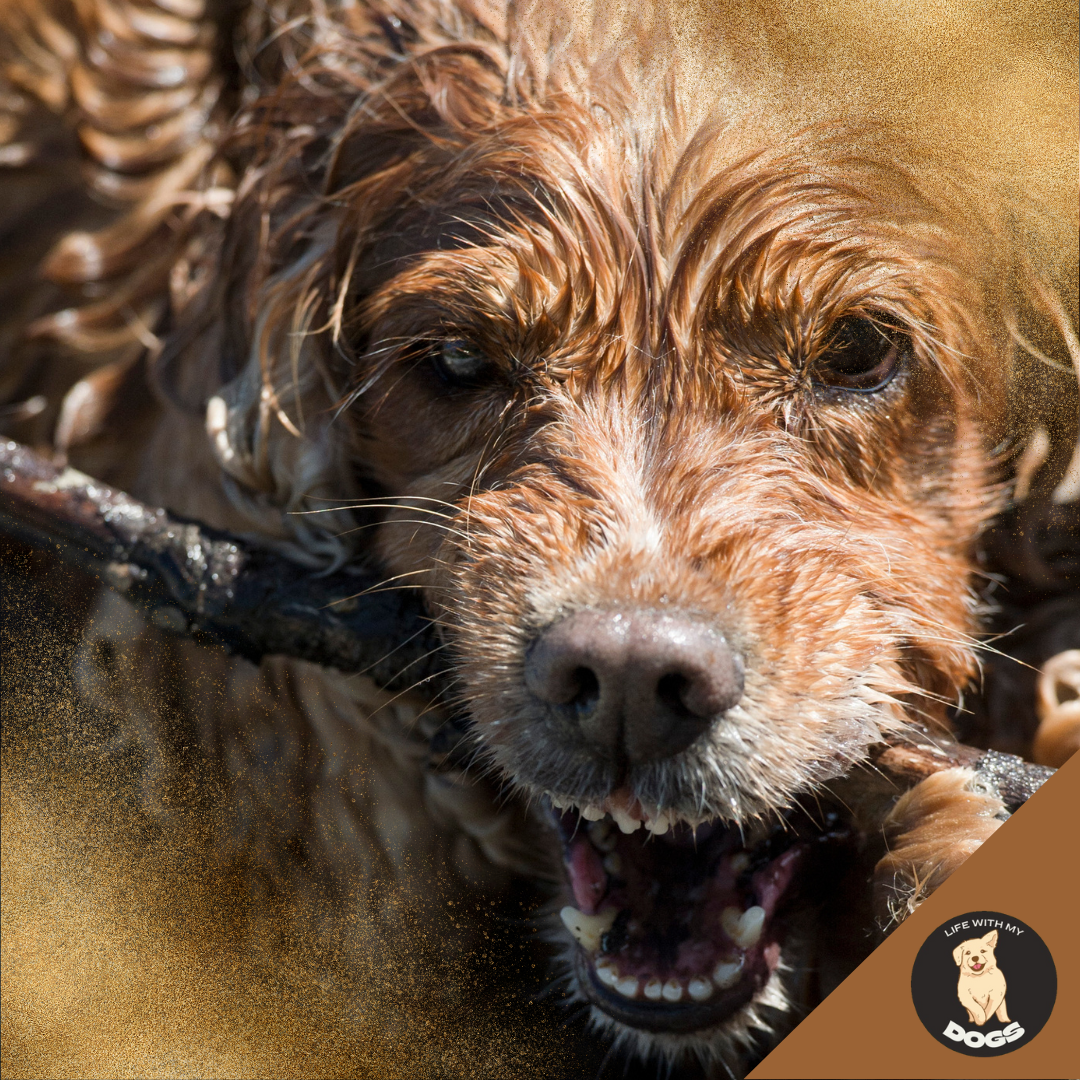
Key Takeaways
- Effective oil removal from a dog’s coat requires prompt action and suitable cleaning supplies.
- A step-by-step approach ensures thorough cleaning without harming the dog’s skin or coat.
- Professional help may be necessary for severe cases or when dealing with toxic substances.
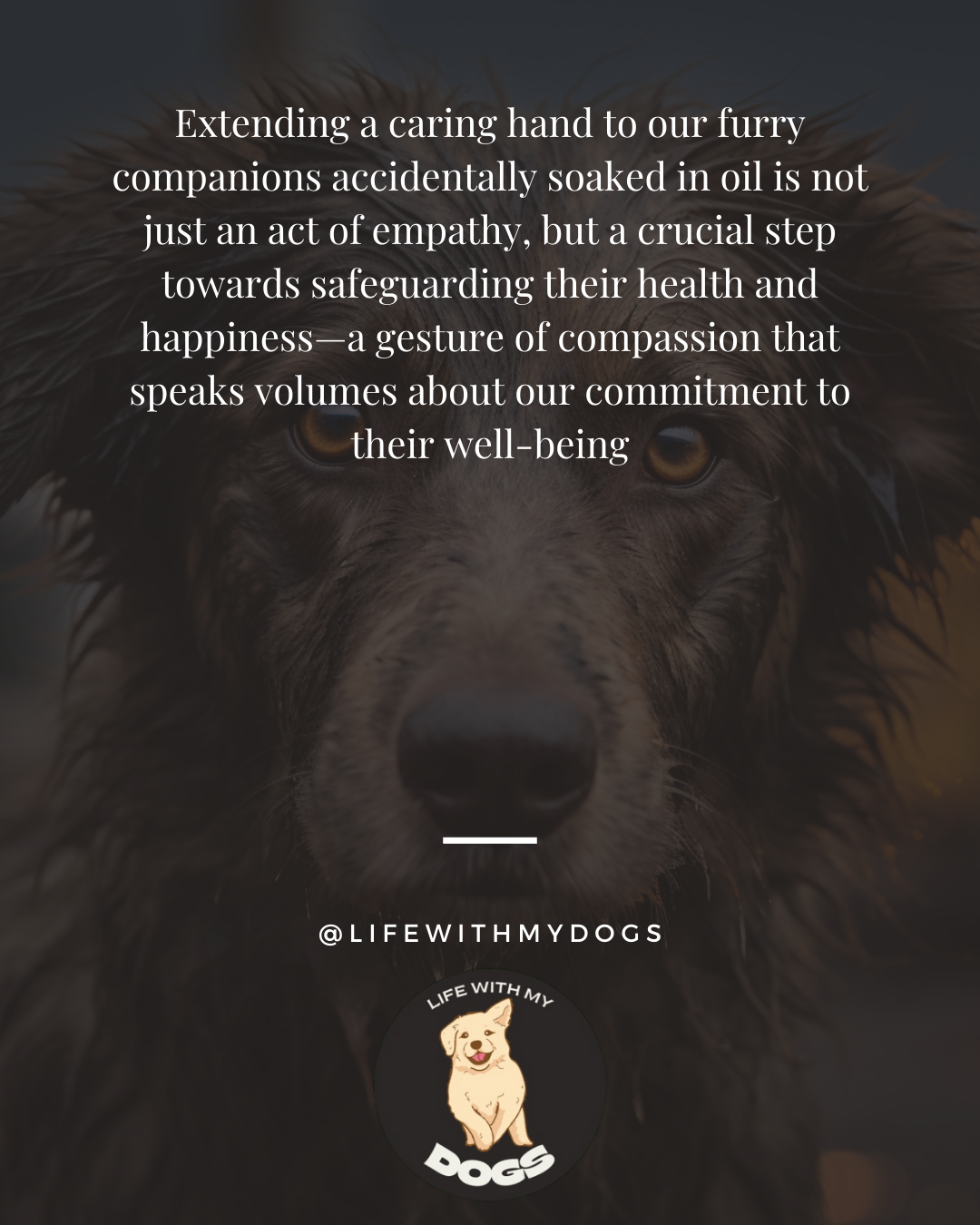
Understanding Oil in a Dog’s Coat
When dealing with oil in your dog’s coat, it’s essential to comprehend the nature of the oil and its source. There are two main types of oil that you might find on your dog’s fur: natural oils from their skin, and foreign oils from external sources.
Natural oils are produced by your dog’s sebaceous glands and serve to keep their skin moisturized and fur healthy. Problems can arise if your dog’s skin produces excess sebum, leading to an oily coat with a distinctive smell, as explained by FirstVet. In contrast, foreign oils—like motor oil or cooking oil—can be accidental contaminants from the environment.

To address oil in your dog’s coat effectively, identify the source:
- Natural Oils: Check for underlying health issues.
- Foreign Oils: Identify the type of oil and act promptly.
If the oil is not naturally produced by your dog, immediate removal is crucial to prevent skin irritation or ingestion during grooming. Sites like Hound Helper provide steps to remove petroleum-based oils using safe methods.
Here’s a quick checklist for dealing with foreign oils:
- Wear gloves to protect your skin.
- Safeguard your dog’s eyes and mouth during cleaning.
- Use a degreasing agent like dish soap for water-insoluble oils.
- Rinse thoroughly to ensure all oil and soap residues are gone.
Remember, if the oiliness persists or you’re unsure about the cause, consult your vet for an accurate diagnosis and treatment plan. Regular grooming and proper care can prevent and manage oily fur, as discussed by Pet Educate.
Fun Fact!
Did you know that a dog’s nose has a unique ‘noseprint’ just like a human fingerprint? This is due to the presence of sebaceous glands that produce natural oils, creating a distinct scent pattern. These oils not only help keep their nose moist but also play a crucial role in their exceptional sense of smell, which is estimated to be up to 100,000 times more sensitive than humans!
Immediate Actions to Take
If your dog’s coat has come into contact with oil, prompt and careful action can help to effectively remove the oil without causing discomfort to your pet. Below is a structured approach to tackle the issue:
Containment
Keep your dog from spreading oil around the house. Place them in an easy-to-clean area such as a tiled bathroom.
Assessment
Quickly assess the amount and type of oil, and check for any signs of skin irritation. It’s crucial to first understand the type of oil and then protect your dog’s sensitive areas such as eyes and mouth. This ensures the cleaning process is safe and effective.
Assess the Type of Oil
Begin by identifying the type of oil in your dog’s fur. Is it a petroleum-based oil or perhaps a cooking oil? This will determine the cleaning method you use. Petroleum-based oils require a specific approach; they can’t be treated the same as biodegradable oils.
If the oil is toxic or the dog has gotten into something potentially harmful, contact your veterinarian immediately.
Protect Your Dog’s Eyes and Mouth
Before starting the cleaning process, safeguard your dog’s eyes and mouth. These are sensitive areas that could be irritated by cleaning agents. You can use eye ointment or protective goggles for the eyes, and keep your dog’s mouth closed while washing to prevent ingestion of any products.
Gather Necessary Supplies
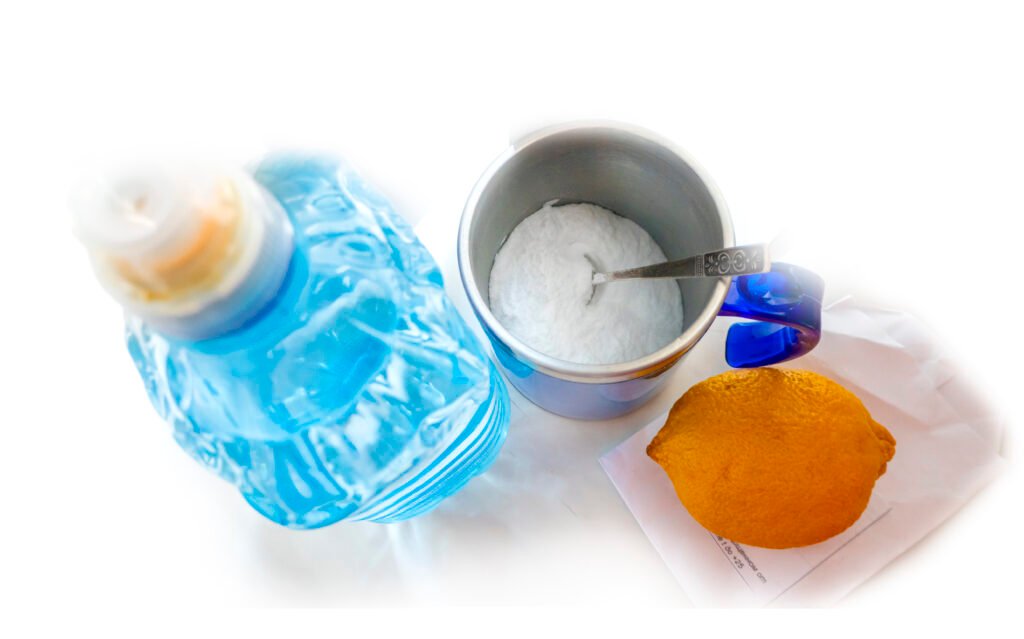
Before attempting to remove oil from your dog’s coat, make sure you have the right supplies on hand. Proper preparation will make the cleaning process smoother and more effective. Here’s a list of items you should gather:
- Warm Water: Ensure you have access to warm water to help break down the oil.
- Mild Dish Soap: Choose a mild, grease-cutting dish soap that is safe for pets, like Dawn, to help dissolve the oil.
- Rubber Gloves: Protect your hands and ensure better grip while working with your dog’s fur.
- Towels: Have several towels ready for both containing the mess and drying your dog.
- Dog Shampoo: After removing the oil, you’ll need a dog-specific shampoo for a final cleanse.
- Comb or Brush: To detangle fur and remove any oil clumps.
- Plastic Bag: To dispose of oily towels and prevent oil from spreading.
Here’s a simple table summarizing the supplies:
| Supply Item | Purpose |
|---|---|
| Warm Water | Softens and breaks down oil. |
| Mild Dish Soap | Cuts through grease and is gentle on your dog’s skin. |
| Rubber Gloves | For hand protection and improved handling. |
| Towels | To clean up and dry your dog. |
| Dog Shampoo | To thoroughly wash out any residue after oil removal. |
| Comb or Brush | To smooth out the fur and remove oil particles. |
| Plastic Bag | To dispose of soiled materials and prevent messes. |
Before you begin, ensure all your supplies are within reach. You don’t want to have to leave your dog unattended during the cleaning process. Make sure the dish soap you use is pet-safe; if in doubt, consult with your veterinarian for recommendations on appropriate cleaning agents.
Step-by-Step Oil Removal Process
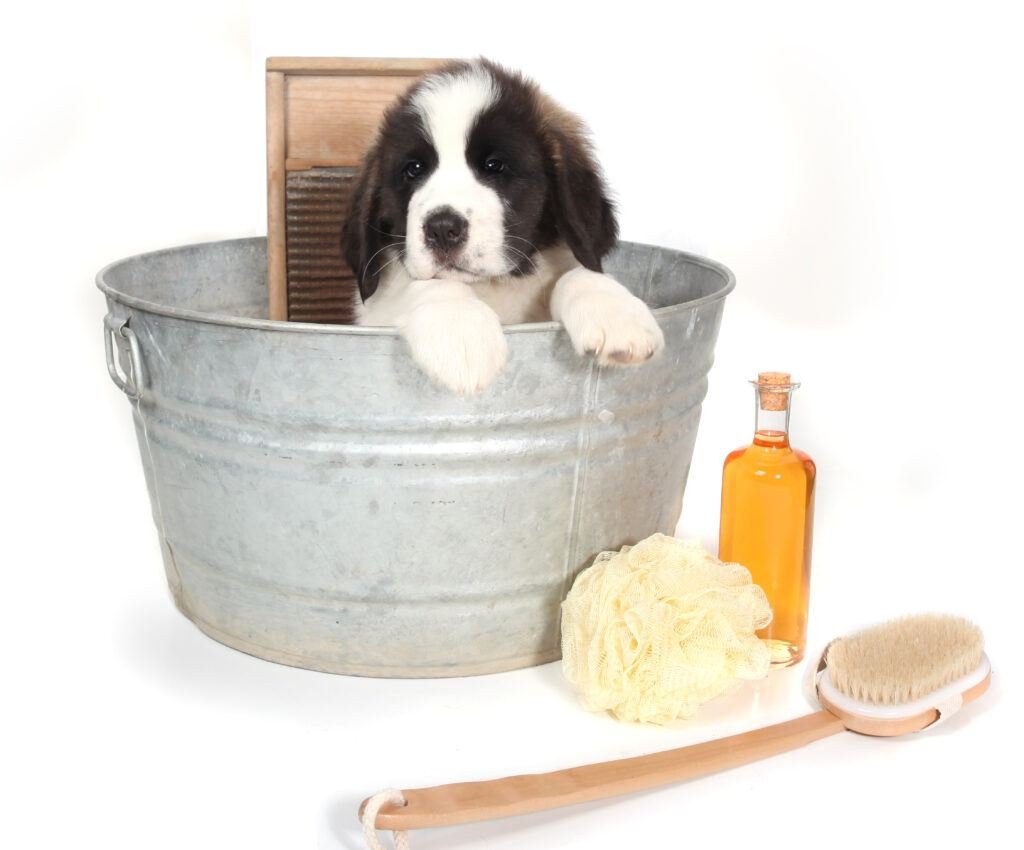
When your dog has oil in its coat, you must act promptly to prevent skin irritation or ingestion during self-grooming. Effectively removing oil from your dog’s coat requires a methodical approach. Each stage is crucial for ensuring all oil is removed without damaging your dog’s fur or skin.
Pre-Treatment and Initial Rinse
Begin by absorbing excess oil with paper towels or rags, taking care not to rub the oil deeper into the coat. Rinse your dog’s coat with warm water to remove any excess oil.
Application
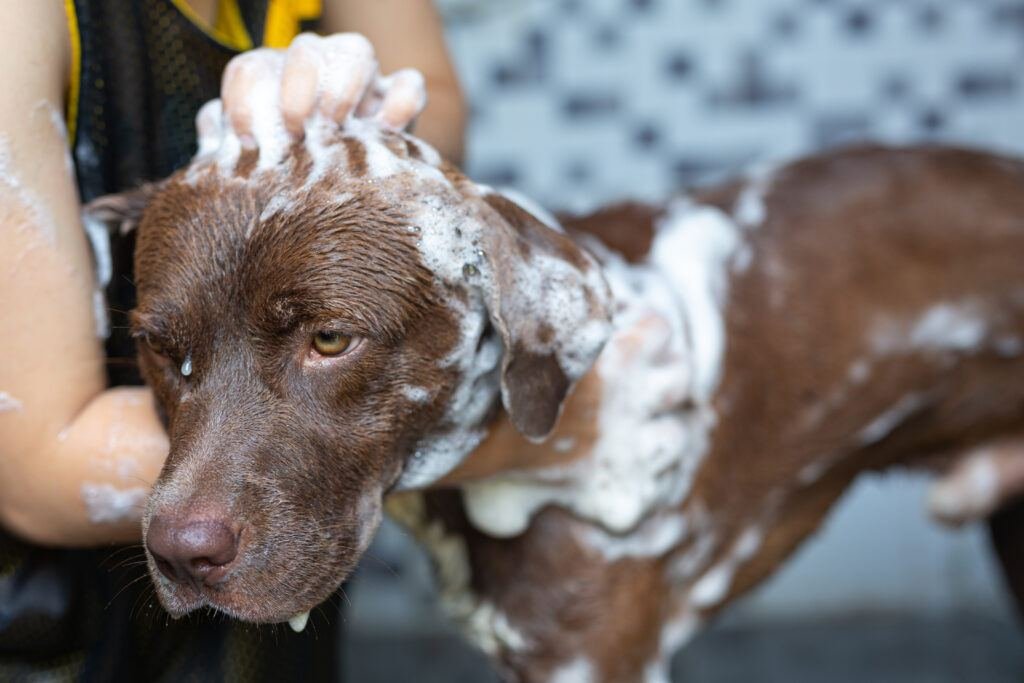
Apply a degreasing agent—such as dish soap—which is known to break down oil, directly on the affected area. Allow it to sit for a few minutes to start dissolving the oil.
- Apply Degreasing Agent
- Use a small amount of dish soap or a dog-specific degreasing shampoo and apply it directly to the oily areas.
- Work to create a lather. Gently massage into the fur, starting from the contaminated areas and expanding outward.
- Let Sit
- Allow the cleaning agent to sit for 3-5 minutes to break down the oil.
Bathing Your Dog
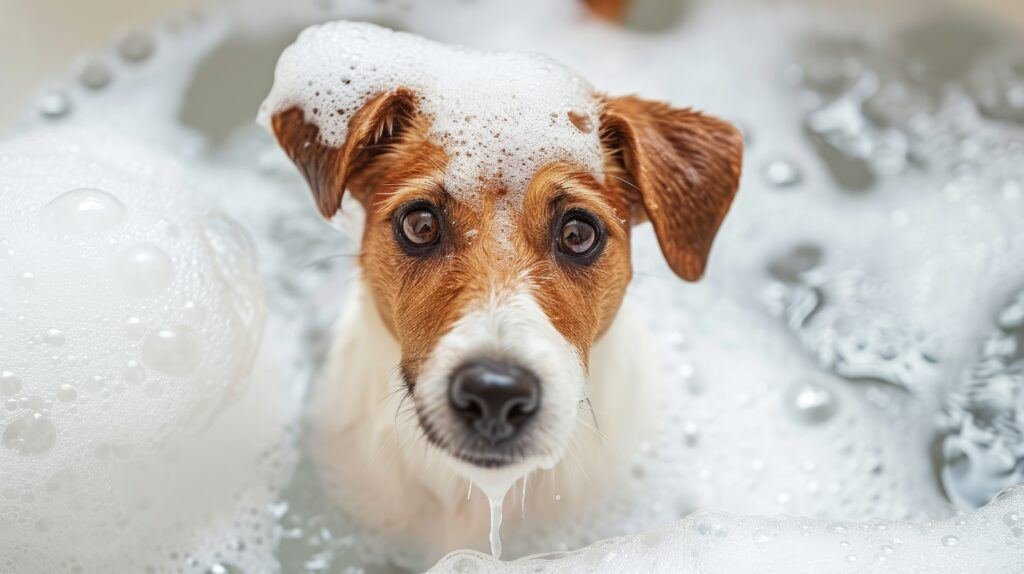
Ensure you thoroughly wet your dog’s fur with warm water before applying the shampoo. When bathing, create a rich lather and massage the soap solution deep into the coat to ensure it reaches the skin. It is important to rinse out all soap thoroughly to avoid skin irritation. The rinsing process may need to be repeated to completely remove all residues.
- Rinse Thoroughly
- Rinse your dog’s fur with warm water until all soap is removed, as residual soap can irritate the skin.
- Repeat if Necessary
- Depending on the oil’s viscosity, you may need to repeat the washing process to fully remove the oil.
Post-Bath Care
After the bath, gently towel-dry your dog to remove moisture. Follow up with a dog-friendly conditioner to restore moisture and shine to the coat, which can be found through recommendations at Hound Helper.
Towel dry and use a comb to gently remove any tangles, and to check for any remaining oily spots. If necessary, use a blow dryer on a low, cool setting to finish drying the fur.
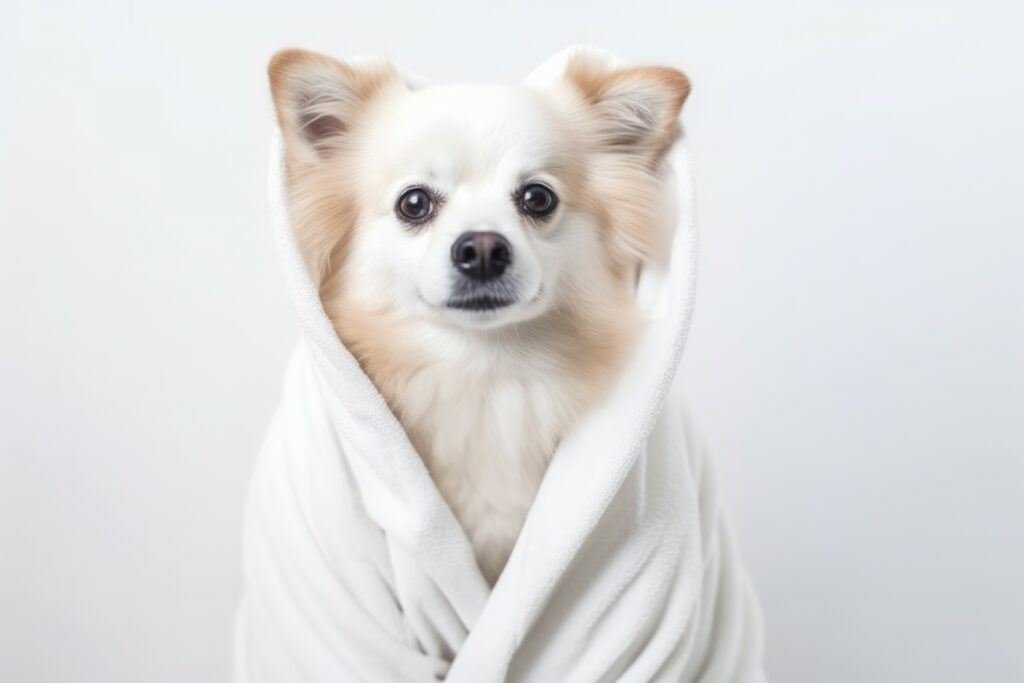
Natural Remedies for Oil Removal
If your dog’s coat has become greasy or tainted with oil, you may prefer a natural approach to resolve the issue. Here are some natural remedies to help get oil out of your dog’s fur:
Dish Soap: A common household item that can be effective is dish soap. It’s designed to cut through grease and can be safe for use on your dog in a pinch. Use a mild, fragrance-free variety to avoid irritating your dog’s skin.
- Step 1: Wet your dog’s fur with warm water.
- Step 2: Apply a small amount of dish soap directly to the oily areas.
- Step 3: Gently massage the soap into the fur to create a lather.
- Step 4: Rinse thoroughly to ensure all soap residue is removed.
Baking Soda: Baking soda can be used to absorb excess oil.
- Step 1: Sprinkle baking soda onto the oily patches of fur.
- Step 2: Gently work it into the fur and let it sit for a few minutes to absorb the oil.
- Step 3: Brush out the baking soda thoroughly.
Vide Credit: @DrBecker
Cornstarch: Similar to baking soda, cornstarch is a great natural oil absorber.
- Step 1: Apply cornstarch to the affected area.
- Step 2: Rub it gently into the fur and let it sit for several minutes.
- Step 3: Brush the cornstarch out, taking the excess oil with it.
When using any of these natural remedies, always patch test a small area first to check for any adverse reactions. Also, remember to reward your dog for their patience with plenty of treats and cuddles.
Preventing Future Incidents
To significantly reduce the risk of your dog’s coat becoming greasy again, regular grooming is crucial.
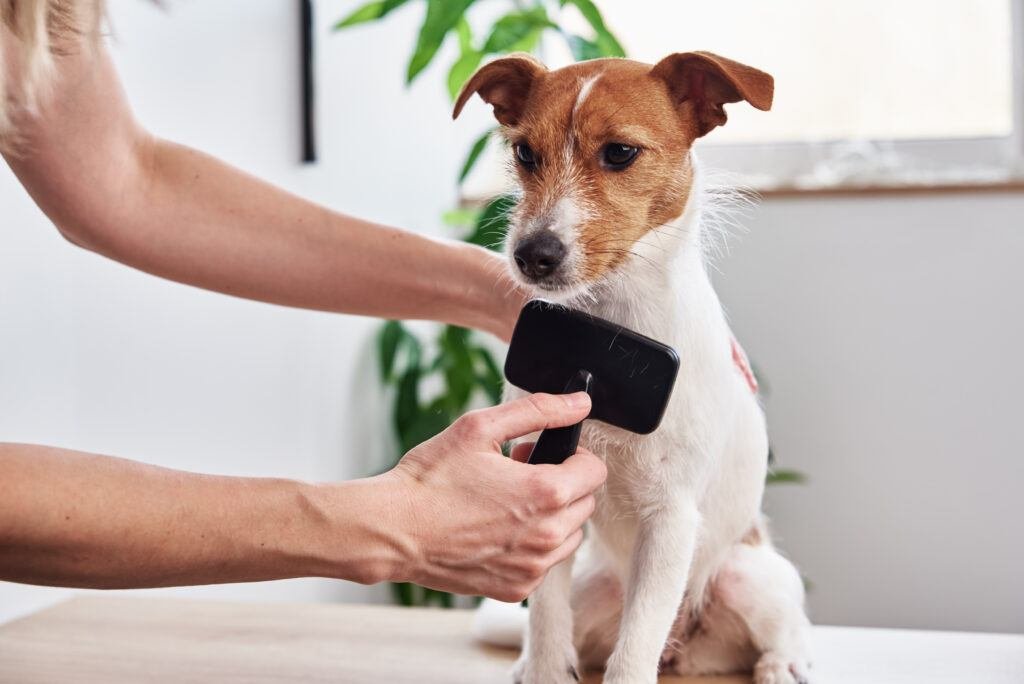
Brush your dog’s fur routinely to distribute natural oils evenly. This also helps remove excess dirt and debris that could contribute to oiliness.
Maintain a balanced diet for your dog. Feeding your dog the right amount of high-quality food can do wonders for their skin and coat health. Be mindful of the ingredients and consider incorporating supplements if recommended by your veterinarian.
Consider the following preventive measures:
- Immediate Cleaning: Clean any spills or areas where your dog may come into contact with oil as soon as possible.
- Protection: When walking or playing in areas where your dog might encounter oily substances, use protective clothing or paw balms.
- Safe Exploring: Keep your dog away from places where they can come into contact with motor oil or cooking oil.
| Activity | Preventive Action |
|---|---|
| Outdoor Play | Supervise to avoid oily puddles or spills. |
| Feeding | Use non-greasy foods to avoid oily residue. |
| Home Environment | Store oils and greasy substances safely. |
When to Seek Professional Help
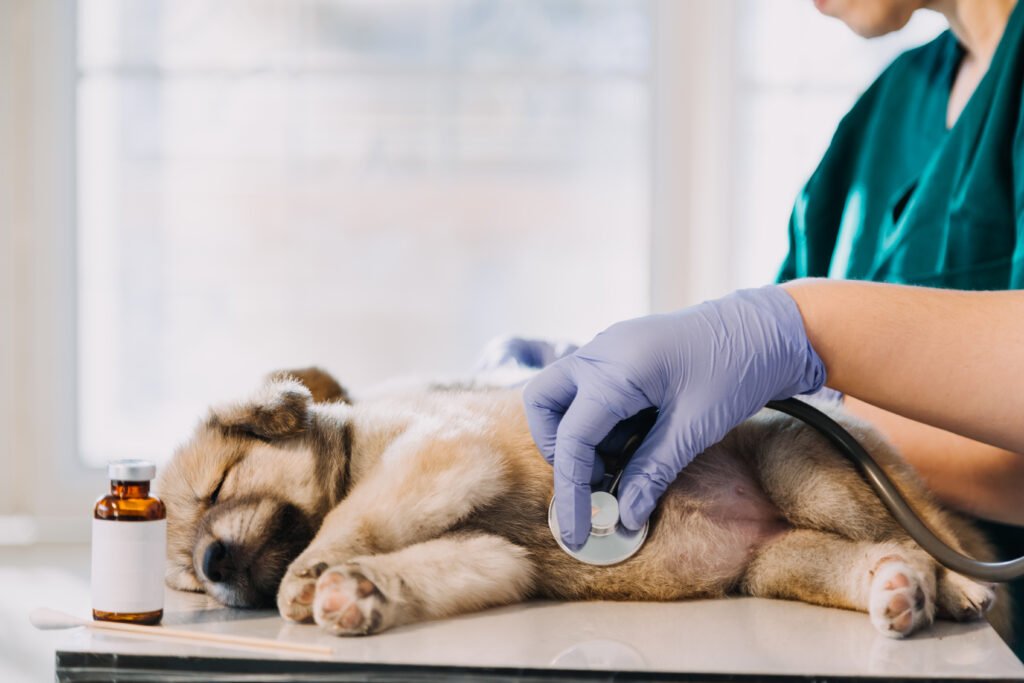
If you’ve attempted to remove oil from your dog’s coat using dog-friendly detergents or home remedies without success, it might be time to seek professional help. Here are specific circumstances where a professional groomer or veterinarian is necessary:
- Persistent Oil: If the oil is not coming out after several washes, consult a professional. A groomer has specialized products and experience in dealing with tough cases.
- Skin Irritation: Look for signs of skin irritation, such as redness, swelling, or rash. If you notice any, it’s essential to visit a vet to avoid further discomfort or infection.
- Ingested Oil: If your dog has ingested oil while trying to lick it off, this could lead to health issues. Seek veterinary care immediately.
- Inaccessibility: If the oil is in an area that’s difficult for you to clean or your dog is uncooperative, professionals can help.
- Unknown Oil Type: If you’re unsure of the oil type, a professional can assess the situation and treat it accordingly.
Video Credit: @MelanieNewmanSalonEssentials
Keeping Your Dog’s Coat Clean
Ensuring that our dog’s coat stays clean is crucial for their health and happiness. With the right approach, removing oil from your dog’s coat, whether due to spills or environmental exposure, becomes stress-free. Acting promptly, using suitable cleaning supplies, and seeking professional help when needed are all key steps to maintaining our furry friend’s coat clean and shiny.
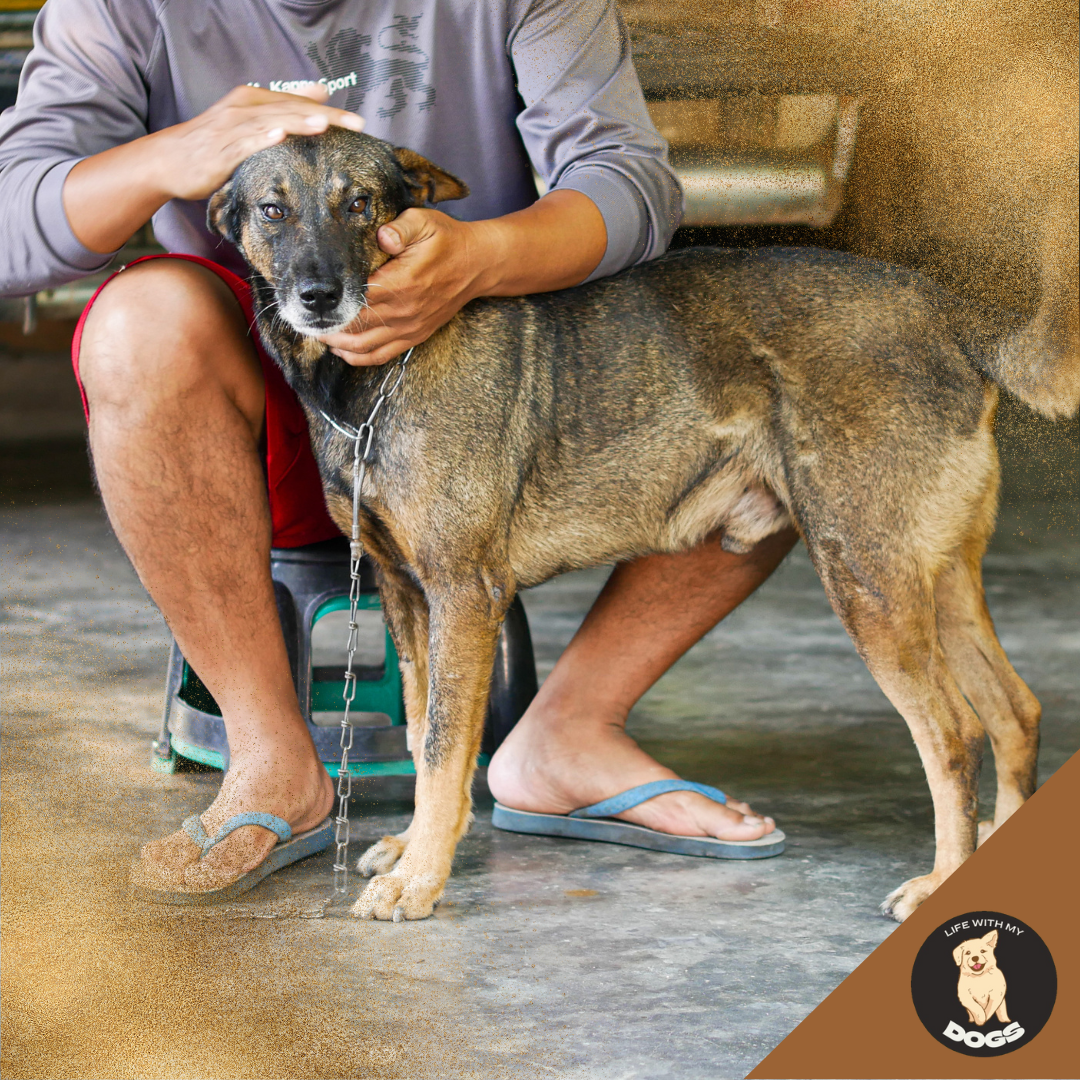
Our beloved dogs deserve the best care possible. Let’s commit to keeping their coat clean, shiny, and free from oil-related issues. Together, we can provide them with endless adventures and cherish the best shared moments. Let’s embark on this journey to care for our furry companions with love and dedication.
Frequently Asked Questions
In this section, you’ll find clear answers to common concerns about removing various types of oil from your dog’s coat.
What is the best method to clean engine oil from a dog's fur?
To clean engine oil from your dog’s fur, use a degreasing dish soap such as Dawn. Wet your dog’s coat thoroughly with warm water, apply the soap, and massage it into the fur, making sure to cover all oily patches. Rinse well to remove both oil and soap. Cleaning oil from your dog’s fur may require repeated washing to get all of the oil out.
What home remedies can be used to remove oil from a dog's coat?
Cornstarch or baking soda can be effective home remedies for removing oil. Sprinkle it on the affected area, let it absorb the oil for a few minutes, then brush it out. Following up with a bath using degreasing soap will help ensure the oil is completely removed.
What should I do if my dog gets olive oil on its fur?
If your dog gets olive oil on its fur, apply cornstarch to the oily areas to absorb the oil before giving your dog a bath. Then, use a mild dish soap to lather and rinse the coat thoroughly. Be patient, as it may take a couple of washes to fully remove the olive oil.
How can I effectively remove black grease from my dog's fur?
To remove black grease, use a degreasing dish soap or a specialized pet degreaser. Apply the product to the greased fur, lather well, and rinse thoroughly. Repeat if necessary to ensure all the grease is removed, as it can be stubborn.
Is it safe to use coconut oil on my dog's fur, and how can I remove it if necessary?
Coconut oil is generally safe for dogs’ fur and can be beneficial for their coat. However, if you need to remove excess coconut oil, use a gentle pet shampoo and warm water. Lather and rinse thoroughly. You may need to wash multiple times to fully remove the coconut oil.
What are the risks of not thoroughly rinsing various oils out of my dog's fur and how can it be done properly?
Not thoroughly rinsing oil from your dog’s fur can lead to skin irritation and matting. To rinse effectively, use warm water and gently massage the coat to break down the oil. Ensure all areas are reached and that the water runs clear before finishing. It’s important for your dog’s skin health to remove all soap and oil residues.

